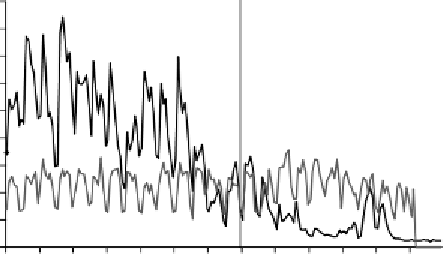Environmental Engineering Reference
In-Depth Information
1800
20.0
Water consumption
18.0
1600
16.0
Heating energy
1400
14.0
1200
Electricity consumption
12.0
1000
10.0
800
8.0
600
6.0
400
4.0
200
2.0
0
0.0
Figure 6.40
Measured daily heating, electricity and water consumption as a basis for internal load
calculations
6.3 Online Simulation of Renewable Energy Plants
As the second application of the new area of online simulation, renewable energy
plants, here photovoltaic power plants, are simulated. Again, photovoltaic system
simulation tools are mostly used for the planning and yield prediction of power plants.
However, the economic performance of grid-connected photovoltaic plants critically
depends on the electricity yield, which is a function of the real installed power and
functionality of the whole system as well as of the given meteorological boundary
conditions. During the commissioning phase of a photovoltaic power plant it is im-
portant to have photovoltaic system models available which can precisely convert the
measured power to standard test conditions. Even if the current-voltage characteristics
is measured during commissioning, a model is still needed for the conversion process.
At varying meteorological boundary conditions, deviations from manufacturers' data
as large as 10-20% of the installed power are difficult to detect.
If deviations between the manufacturers' data and the measured power could be re-
liably detected using conversion routines from simulation models, the commissioning
procedure would be improved. The same applies to the operation phase of a photo-
voltaic generator: if even small deviations between real power and nominal power
can be noted by a reliable simulation model able to calculate the nominal perfor-
mance, then fault detection can be automated without the need for highly qualified
engineering work. High-performance photovoltaic simulation tools such as INSEL,





































































































































Search WWH ::

Custom Search